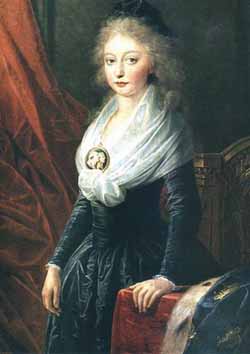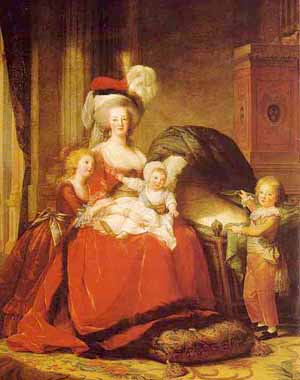 |
 |
History: Personalities
Madame Royale and the
Death of Innocence
Elena Maria Vidal
"She did not know why she had been spared. Her inner suffering increased as she discovered that it is sometimes more agonizing to live than to die....It would feel so strange to be out in the world again; so strange and so frightening. The Temple was the only home she had known since she was fourteen. To leave it would be severing the last links with her family. She would be going to a distant land, a penniless orphan, to relations she did not know. She, Madame Royale...."
Excerpt from Trianon by Elena Maria Vidal

Marie-Thérèse was the first child born to King Louis XVI and Queen Marie Antoinette |
How dark must have been the thoughts of Marie-Therese-Charlotte of France on the midnight of December 18, 1795, the eve of her seventeenth birthday, as she prepared to be sent to her relatives in Austria. She had not only experienced a bloody revolution, but she had been subjected to verbal abuse and the constant threat of physical molestation.
One by one, her parents, her brother, and her aunt had been taken away, until she was alone in the dreary Temple prison in Paris. Before being guillotined, Madame Elisabeth [the sister of King Louis XVI] had instructed her niece not to ever let the jailers find her undressed or in bed. The young girl spent many nights sitting in a chair, trembling in the darkness, since when her candles burned out they were not replaced.
The orphaned daughter of Louis XVI and Marie-Antoinette was aware that her small brother Charles was in the room below, ill and abused with no one to care for him. She was not permitted to see him and when he died of tuberculosis at the age of ten on June 8, 1795, she was not allowed to keep vigil by his corpse. Only when his body was removed was Madame Royale allowed to go down into the garden. She ever after harbored doubts as to whether her brother had really died. There were rumors that he had been replaced by another boy, rumors which are the subject of my novel Madame Royale.
Deborah Cadbury describes the torments to which the Dauphin was subjected in her marvellous book The Lost King of France. People have lamented that my novels have too much religion in them. Therefore, I was delighted to see that Cadbury makes reference to almost all of the same incidents in which the royal family displayed Christian fortitude, in their prayers and in the forgiveness of injuries.

One of the last portraits that Vigee Le Brun painted (1787) of the Queen and her children, Madame Royale, the Dauphin, and the infant Louis Joseph who died of natural causes in 1789. |
Cadbury relates how the Dauphin, when caught saying his prayers as his mother had taught him, was kicked in the face by Simon his jailer. The poor child was shown pornography, given alcohol, and pressured into accusing his own mother of incest. His sister Marie-Therese was present when he made the formal accusation. He grasped at her hand before he was led away but she never saw him again.
The children of Louis XVI and Marie-Antoinette were not the only innocents to suffer during the Revolution. Many French people, particularly the peasants of the Vendée, rebelled against the Liberty, Equality, and Fraternity that were being imposed upon them through bloodshed. They resented their churches being taken over and eventually closed by Republic, while the priests were killed or exiled. They took up arms and Austrian scholar Eric von Keuhnelt-Leddihn describes the harsh brutality which the Revolutionary government exercised upon the uncooperative citizens. General Westermann and his bleus were especially notorious for their sadism towards children. There were atrocities all over the Vendee, and in Lyon and other French towns and cities where the Revolution was not appreciated.
It was the blueprint for the mass murders of the totalitarian regimes of later centuries. Many children died, many young lives were shattered at the dawn of the modern world. Madame Royale was the living symbol of all the lost children of France.
Posted by Elena Maria Vidal at her blogsite Tea at Trianon on November 22, 2006

Related Topics of Interest
 Louise of France and Her Counter-Revolutionary Action Louise of France and Her Counter-Revolutionary Action
 Unmasking the Formidable Myth about Queen Marie Antoinette Unmasking the Formidable Myth about Queen Marie Antoinette
 Nobility and Accessibility: Keys of Catholic Charity Nobility Nobility and Accessibility: Keys of Catholic Charity Nobility
 Queen St. Clotilda: Patroness for the Reign of Mary Queen St. Clotilda: Patroness for the Reign of Mary
 The Personality of Charlemagne The Personality of Charlemagne
 Revolution and Counter-Revolution - Overview Revolution and Counter-Revolution - Overview

|
History | Home | Books | CDs | Search | Contact Us | Donate

© 2002-
Tradition in Action, Inc. All Rights Reserved
|
 |
|